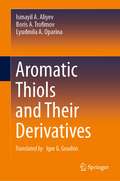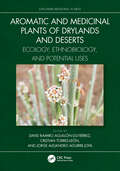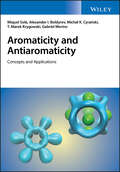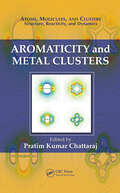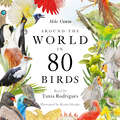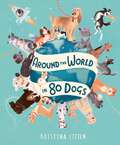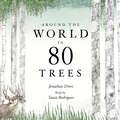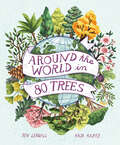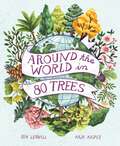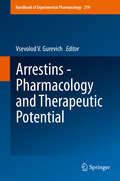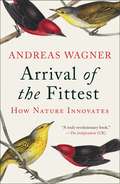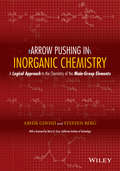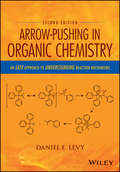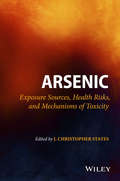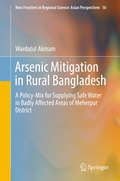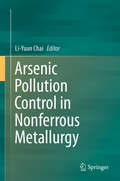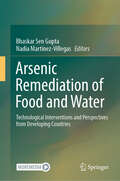- Table View
- List View
Aromatic Thiols and Their Derivatives
by Boris A. Trofimov Ismayil A. Aliyev Lyudmila A. OparinaThis book is devoted to the synthetic and physical chemistry of aromatic thiols and their closest derivatives, sulfides, sulfoxides, sulfones, including those substituted by various functional groups such as acyl and thioacyl, alkoxide, ester, hydroxyl and halogens. In some cases, for comparison, selenium and oxygen analogues are also detailed. The main focus of the book is on synthetic methods, both traditional and new, based on the use of transition metals as catalysts, as well as the reactivity of the compounds obtained. Its addition to the influence of conformational and electronic factors on spectral (NMR, IR, UV, NQR) and electrochemical characteristics of the compounds is presented. Finally, the book describes the application of aromatic thiols and their derivatives as drug precursors, high-tech materials, building blocks for organic synthesis, analytical reagents and additives for oils and fuels. It is a useful handbook for all those interested in organosulfur chemistry.
Aromatic and Medicinal Plants of Drylands and Deserts: Ecology, Ethnobiology, and Potential Uses (Exploring Medicinal Plants)
by David Ramiro Aguillón-Gutiérrez, Cristian Torres-León, and Jorge Alejandro Aguirre-JoyaThe description and analysis of the Mexican and other countries desertic plants from the point of view of their use in traditional medicine and their potential use in integrative medicine is the overall theme of this book. Aromatic and Medicinal Plants of Drylands and Deserts: Ecology, Ethnobiology and Potential Uses describes the historic use of drylands plants, botanical and geological classification, also describes the endemic plants used in traditional medicine, going through the most relevant aspects of biomedicine and integrative medicine. The chemical and bioactive compounds from desertic medicinal and aromatic plants and the analytic techniques to determine chemical and bioactive compounds from the medicinal and aromatic plants are reviewed. Ethnobiology is detailed in the present book as well as the importance of the integrative medicine for the ancient and actual cultures. The book represents an effort to keep the ethnobiological knowledge of communities for the use of traditional desertic plants with the actual analytical techniques to unveil the chemical molecules responsible of the biological or biomedical applications. Features: • Describes the endemic plants used in traditional medicine • Includes the chemical and bioactive compounds from desertic medicinal plants • Addresses the analytic techniques to determine chemical and bioactive compounds • Represents an effort to keep the ethnobiological knowledge of communities To execute this book, there are collaborations by authors from different institutions in northern Mexico, which is where the arid and semi-arid ecosystems of the country are found. Although the subject of medicinal plants has been treated from different angles, this book offers a holistic and comprehensive vision of these important organisms of the Mexican desert, thus resulting in an updated work for specialized readers and for those who are beginning in this exciting theme.
Aromaticity and Antiaromaticity: Concepts and Applications
by Miquel Solà Alexander I. Boldyrev Michal K. Cyrañski Tadeusz M. Krygowski Gabriel MerinoAromaticity and Antiaromaticity A comprehensive review of the science of aromaticity, as well as its evolution, from benzene to atomic clusters In Aromaticity and Antiaromaticity: Concepts and Applications, a team of accomplished chemists delivers a comprehensive exploration of the evolution and critical aspects of aromaticity. The book examines the new global criteria used to evaluate aromaticity, including the Nucleus Independent Chemical Shift (NICS) index and the electronic indices based on electronic properties. Additional discussions of inorganic aromatic compounds developed in this century, which give rise to new concepts like multifold aromaticity, are included. Three-dimensional aromaticity found in fullerenes and nanotubes, Möbius aromaticity present in some annulenes, and excited state aromaticity are explored as well. This volume explores the geometrical, electronic, magnetic, and thermodynamic characteristics of aromatic and antiaromatic compounds and their reactivity properties. It also provides: A thorough historical overview of aromaticity, as well as simple electronic and structural models Comprehensive explorations of organic and inorganic aromatic compounds, concepts of stability and reactivity, and geometric, energetic, magnetic, and electronic criteria of descriptors of aromaticity Practical discussions of heteroaromaticity, as well as Möbius aromaticity and excited state aromaticity In-depth examinations of sigma, pi, delta, and phi aromaticity Perfect for graduate students, researchers, and academics interested in aromaticity, organometallic chemistry, and computational chemistry, Aromaticity and Antiaromaticity: Concepts and Applications will also earn a place in the libraries of professionals and researchers working in organic, inorganic, and physical chemistry.
Aromaticity and Metal Clusters (Atoms, Molecules, and Clusters)
by Pratim Kumar ChattarajMetal clusters, an intermediate state between molecules and the extended solid, show peculiar bonding and reactivity patterns. Their significance is critical to many areas, including air pollution, interstellar matter, clay minerals, photography, catalysis, quantum dots, and virus crystals. In Aromaticity and Metal Clusters, dozens of international
Around the World in 80 Birds
by Mike UnwinThis beautiful and inspiring book tells the stories of 80 birds around the world: from the Sociable Weaver Bird in Namibia which constructs huge, multi-nest 'apartment blocks' in the desert, to the Bar-headed Goose of China, one of the highest-flying migrants which crosses the Himalayas twice a year.Many birds come steeped in folklore and myth, some are national emblems and a few have inspired scientific revelation or daring conservation projects. Each has a story to tell that sheds a light on our relationship with the natural world and reveals just how deeply birds matter to us.
Around the World in 80 Birds
by Mike UnwinThis beautiful and inspiring book tells the stories of 80 birds around the world: from the Sociable Weaver Bird in Namibia which constructs huge, multi-nest 'apartment blocks' in the desert, to the Bar-headed Goose of China, one of the highest-flying migrants which crosses the Himalayas twice a year.Many birds come steeped in folklore and myth, some are national emblems and a few have inspired scientific revelation or daring conservation projects. Each has a story to tell that sheds a light on our relationship with the natural world and reveals just how deeply birds matter to us.
Around the World in 80 Birds
by Mike UnwinThis beautiful and inspiring book tells the stories of 80 birds around the world: from the Sociable Weaver Bird in Namibia which constructs huge, multi-nest 'apartment blocks' in the desert, to the Bar-headed Goose of China, one of the highest-flying migrants which crosses the Himalayas twice a year.Many birds come steeped in folklore and myth, some are national emblems and a few have inspired scientific revelation or daring conservation projects. Each has a story to tell that sheds a light on our relationship with the natural world and reveals just how deeply birds matter to us.
Around the World in 80 Dogs (Around the World in 80 #5)
by Kristyna LittenWhat is the oldest breed of dog? Can dogs sniff out illnesses? Which breed has six toes?Including a stunning central gatefold that opens out to reveal all 80 dog breeds and where they come from, this book is a visual celebration of the huge variety of dogs found across the world, from those you already know and love to those that may surprise you. As the book takes the reader on a journey around the world, it reveals dogs with the most important jobs, breeds with unusual features, record-breaking dogs and more.Focus spreads will explore subjects such as the canine family, dogs' superpower sense of smell, and how dogs became man's best friend.
Around the World in 80 Plants
by Jonathan DroriAn inspirational and beautifully illustrated book that tells the stories of 80 plants from around the globe.In his follow-up to the bestselling Around the World in 80 Trees, Jonathan Drori takes another trip across the globe, bringing to life the science of plants by revealing how their worlds are intricately entwined with our own history, culture and folklore. From the seemingly familiar tomato and dandelion to the eerie mandrake and Spanish 'moss' of Louisiana, each of these stories is full of surprises. Some have a troubling past, while others have ignited human creativity or enabled whole civilizations to flourish. With a colourful cast of characters all brought to life by illustrator Lucille Clerc, this is a botanical journey of beauty and brilliance.'A beautiful celebration of the plants and flowers that surround us and a quiet call to arms for change' The Herald'This charming and beautifully illustrated book takes readers on a voyage of discovery, exploring the many ingenious and surprising uses for plants in modern science and throughout history' Kew Magazine'With beautiful illustrations from Lucille Clerc, this captivating book traverses the globe via plants: nettles in England, mangoes in India and tulips in the Netherlands' Daily Mail
Around the World in 80 Plants
by Jonathan DroriAn inspirational and beautifully illustrated book that tells the stories of 80 plants from around the globe.In his follow-up to the bestselling Around the World in 80 Trees, Jonathan Drori takes another trip across the globe, bringing to life the science of plants by revealing how their worlds are intricately entwined with our own history, culture and folklore. From the seemingly familiar tomato and dandelion to the eerie mandrake and Spanish 'moss' of Louisiana, each of these stories is full of surprises. Some have a troubling past, while others have ignited human creativity or enabled whole civilizations to flourish. With a colourful cast of characters all brought to life by illustrator Lucille Clerc, this is a botanical journey of beauty and brilliance.'A beautiful celebration of the plants and flowers that surround us and a quiet call to arms for change' The Herald'This charming and beautifully illustrated book takes readers on a voyage of discovery, exploring the many ingenious and surprising uses for plants in modern science and throughout history' Kew Magazine'With beautiful illustrations from Lucille Clerc, this captivating book traverses the globe via plants: nettles in England, mangoes in India and tulips in the Netherlands' Daily Mail
Around the World in 80 Plants
by Jonathan DroriAn inspirational and beautifully illustrated book that tells the stories of 80 plants from around the globe.In his follow-up to the bestselling Around the World in 80 Trees, Jonathan Drori takes another trip across the globe, bringing to life the science of plants by revealing how their worlds are intricately entwined with our own history, culture and folklore. From the seemingly familiar tomato and dandelion to the eerie mandrake and Spanish 'moss' of Louisiana, each of these stories is full of surprises. Some have a troubling past, while others have ignited human creativity or enabled whole civilizations to flourish. With a colourful cast of characters all brought to life by illustrator Lucille Clerc, this is a botanical journey of beauty and brilliance.Praise for Around the World in 80 Trees"Beautiful to behold and to read" - THE SUNDAY TIMES"An arboreal odyssey" - NATURE"One of the most quietly beautiful books of the year" - DAILY MAIL"Jonathan Drori's deep-seated love of nature is contagious in this tree-by-tree journey across countries and continents. A book to take your time over" - WIRED"A brilliant blend of science, history, culture and folklore, this interesting and engaging book explores the relationship between people and trees as it circumnavigates the globe.The quietly passionate writing is informative, interesting and quite delightful. The hardback version, which I've got, is one of the best-produced books I've read in years: the formatting is crisp and inviting, the paper is heavy and of high quality, and almost every page includes colour drawings by artist Lucille Clerc that are simply breathtaking. Together, these features make this book a joy to touch, to hold and to read." - FORBES
Around the World in 80 Trees
by Jonathan Drori Lucille Clerc"An arboreal odyssey" - NATURE"One of the most quietly beautiful books of the year" - DAILY MAILDiscover the secretive world of trees in Jonathan Drori's number one bestseller...Bestselling author and environmentalist Jonathan Drori follows in the footsteps of Phileas Fogg as he tells the stories of 80 magnificent trees from all over the globe.In Around the World in 80 Trees, Jonathan Drori uses plant science to illuminate how trees play a role in every part of human life, from the romantic to the regrettable. From the trees of Britain, to India's sacred banyan tree, they offer us sanctuary and inspiration - not to mention the raw materials for everything from aspirin to maple syrup.Stops on the trip include the lime trees of Berlin's Unter den Linden boulevard, which intoxicate amorous Germans and hungry bees alike, the swankiest streets in nineteenth-century London, which were paved with Australian eucalyptus wood, and the redwood forests of California, where the secret to the trees' soaring heights can be found in the properties of the tiniest drops of water.Each of these strange and true tales - populated by self-mummifying monks, tree-climbing goats and ever-so-slightly radioactive nuts - is illustrated by Lucille Clerc, taking the reader on a journey that is as informative as it is beautiful. The book combines history, science and a wealth of quirky detail - there should be surprises for everyone.Perfect for fans of Peter Wohlleben's The Hidden Life of Trees, this new book will certainly whet the appetite of any tree lover to take an around-the-world trip, or simply visit your local botanic garden. The perfect travel guide for nature enthusiasts."An irresistible mix of science, culture, botany, history and vicarious travel" - SYDNEY MORNING HERALD"Reads like a love song to the natural world, brimming with ancient anecdotes contained within the earth" - CULTURE TRIP
Around the World in 80 Trees (Around the World in 80 #3)
by Ben LerwillWhere can you find Methuselah, the oldest tree in the world? Why is the baobab's trunk so fat? Can trees really warn each other that something is about to eat them? Including a stunning central gatefold that opens out to reveal all 80 trees and how they relate to each other, this book is a visual celebration of the huge variety of trees found across the world, from those you know to those you almost certainly don't. As the book takes the reader on a journey around the world, it reveals trees that give us food and medicine, trees with ancient legends, record-breaking trees and more. Focus spreads will explore subjects such as the life cycle of trees, how they communicate with each other, why trees are vital to the Earth's health, and their importance to us.
Around the World in 80 Trees (Around the World in 80 #3)
by Ben LerwillWhere can you find Methuselah, the oldest tree in the world? Why is the baobab's trunk so fat? Can trees really warn each other that something is about to eat them?Including a stunning central gatefold that opens out to reveal all 80 trees and how they relate to each other, this book is a visual celebration of the huge variety of trees found across the world, from those you know to those you almost certainly don't. As the book takes the reader on a journey around the world, it reveals trees that give us food and medicine, trees with ancient legends, record-breaking trees and more.Focus spreads will explore subjects such as the life cycle of trees, how they communicate with each other, why trees are vital to the Earth's health, and their importance to us.
Around the World in 80 Trees (Around the World in 80 #3)
by Ben LerwillJourney around the globe to gaze up at towering redwoods, marvel at monkey puzzles, and find out which tree has fish swimming around its roots. Discover trees that give us beautiful flowers, delicious treats, and life-saving medicines—and bizarre trees with bloodred sap, fruit that can be used as soap, or even burned as candles. Learn how trees communicate with each other and how they helped us journey to the farthest reaches of our world. Bursting with blossom and the rustling of leaves, explore the tallest, the smallest, and everything in between.Includes a stunning central gatefold that opens out to reveal all 80 trees and how they relate to each other. Focus spreads explore subjects such as the life cycle of trees, how they communicate with each other, why trees are vital to the Earth's health, and their importance to us.A visual celebration of the huge variety of trees found across the globe, from those you know to those you almost certainly don't!
Aroused: The History Of Hormones And How They Control Just About Everything
by Randi Hutter EpsteinA guided tour through the strange science of hormones and the age-old quest to control them. Metabolism, behavior, sleep, mood swings, the immune system, fighting, fleeing, puberty, and sex: these are just a few of the things our bodies control with hormones. Armed with a healthy dose of wit and curiosity, medical journalist Randi Hutter Epstein takes us on a journey through the unusual history of these potent chemicals from a basement filled with jarred nineteenth-century brains to a twenty-first-century hormone clinic in Los Angeles. Brimming with fascinating anecdotes, illuminating new medical research, and humorous details, Aroused introduces the leading scientists who made life-changing discoveries about the hormone imbalances that ail us, as well as the charlatans who used those discoveries to peddle false remedies. Epstein exposes the humanity at the heart of hormone science with her rich cast of characters, including a 1920s doctor promoting vasectomies as a way to boost libido, a female medical student who discovered a pregnancy hormone in the 1940s, and a mother who collected pituitaries, a brain gland, from cadavers as a source of growth hormone to treat her son. Along the way, Epstein explores the functions of hormones such as leptin, oxytocin, estrogen, and testosterone, demystifying the science of endocrinology. A fascinating look at the history and science of some of medicine’s most important discoveries, Aroused reveals the shocking history of hormones through the back rooms, basements, and labs where endocrinology began.
Arrestins - Pharmacology and Therapeutic Potential (Handbook of Experimental Pharmacology #219)
by Vsevolod V. GurevichThis volume describes our current understanding of the biological role of visual and non-visual arrestins in different cells and tissues, focusing on the mechanisms of arrestin-mediated regulation of GPCRs and non-receptor signaling proteins in health and disease. The book covers wide range of arrestin functions, emphasizing therapeutic potential of targeting arrestin interactions with individual partners.
Arrival of the Fittest
by Andreas Wagner"Natural selection can preserve innovations, but it cannot create them. Nature's many innovations--some uncannily perfect--call for natural principles that accelerate life's ability to innovate." Darwin's theory of natural selection explains how useful adaptations are preserved over time. But the biggest mystery about evolution eluded him. As genetics pioneer Hugo de Vries put it, "natural selection may explain the survival of the fittest, but it cannot explain the arrival of the fittest." Can random mutations over a mere 3.8 billion years really be responsible for wings, eyeballs, knees, camouflage, lactose digestion, photosynthesis, and the rest of nature's creative marvels? And if the answer is no, what is the mechanism that explains evolution's speed and efficiency? In Arrival of the Fittest, renowned evolutionary biologist Andreas Wagner draws on over fifteen years of research to present the missing piece in Darwin's theory. Using experimental and computational technologies that were heretofore unimagined, he has found that adaptations are not just driven by chance, but by a set of laws that allow nature to discover new molecules and mechanisms in a fraction of the time that random variation would take. Consider the Arctic cod, a fish that lives and thrives within six degrees of the North Pole, in waters that regularly fall below 0 degrees. At that temperature, the internal fluids of most organisms turn into ice crystals. And yet, the arctic cod survives by producing proteins that lower the freezing temperature of its body fluids, much like antifreeze does for a car's engine coolant. The invention of those proteins is an archetypal example of nature's enormous powers of creativity. Meticulously researched, carefully argued, evocatively written, and full of fascinating examples from the animal kingdom, Arrival of the Fittest offers up the final puzzle piece in the mystery of life's rich diversity.
Arrow Pushing in Inorganic Chemistry
by Abhik Ghosh Steffen BergInvolved as it is with 95% of the periodic table, inorganic chemistry is one of the foundational subjects of scientific study. Inorganic catalysts are used in crucial industrial processes and the field, to a significant extent, also forms the basis of nanotechnology. Unfortunately, the subject is not a popular one for undergraduates. This book aims to take a step to change this state of affairs by presenting a mechanistic, logical introduction to the subject. Organic teaching places heavy emphasis on reaction mechanisms - "arrow-pushing" - and the authors of this book have found that a mechanistic approach works just as well for elementary inorganic chemistry. As opposed to listening to formal lectures or learning the material by heart, by teaching students to recognize common inorganic species as electrophiles and nucleophiles, coupled with organic-style arrow-pushing, this book serves as a gentle and stimulating introduction to inorganic chemistry, providing students with the knowledge and opportunity to solve inorganic reaction mechanisms. * The first book to apply the arrow-pushing method to inorganic chemistry teaching * With the reaction mechanisms approach ("arrow-pushing"), students will no longer have to rely on memorization as a device for learning this subject, but will instead have a logical foundation for this area of study * Teaches students to recognize common inorganic species as electrophiles and nucleophiles, coupled with organic-style arrow-pushing * Provides a degree of integration with what students learn in organic chemistry, facilitating learning of this subject * Serves as an invaluable companion to any introductory inorganic chemistry textbook
Arrow-Pushing in Organic Chemistry: An Easy Approach to Understanding Reaction Mechanisms
by Daniel E. LevyOrganic chemistry is required coursework for degrees in life, food, and medical sciences. To help the students discouraged by the belief that this topic cannot be mastered without significant memorization, Arrow Pushing in Organic Chemistry serves as a handy supplement for understanding the subject.• Includes new chapters, an expanded index, and additional problem sets complete with detailed solutions• Focuses on understanding the mechanics and logic of organic reaction mechanisms• Introduces ionic and non-ionic reactive species and reaction mechanisms• Teaches strategies to predict reactive species, sites of reactions, and reaction products• Provides a solid foundation upon which organic chemistry students can advance with confidence
Arsenic
by J. Christopher StatesThis book illustrates the chemistry, toxicology, and health effects of arsenic using novel modeling techniques, case studies, experimental data, and future perspectives.* Covers exposure sources, health risks, and mechanisms of one of the most toxic minerals in the world* Helps readers understand potential health effects of arsenic, using population studies, mammalian and invertebrate models, and pharmacokinetic and toxicokinetic models* Discusses outcomes, epidemiology, real-life examples, and modes of action for arsenic-induced diseases, like lung cancer, diabetes, cardiovascular and pulmonary diseases, and immunotoxicity* Acts as a reference for toxicologists, environmental chemists, and risk assessors and includes up-to-date, novel modeling techniques for scientists* Includes future perspectives on special topics, like extrapolation from experimental models to human exposures, biomarkers for phenotypic anchoring, and pathology of chronic exposure
Arsenic & Rice
by Andrew A. Meharg Fang-Jie ZhaoRice is the staple food for half of the world's population. Consumption of rice is the major exposure route globally to the class one, non-threshold carcinogen inorganic arsenic. This book explains the sources of arsenic to paddy soils and the biogeochemical processes and plant physiological attributes of paddy soil-rice ecosystems that lead to high concentrations of arsenic in rice grain. It presents the global pattern of arsenic concentration and speciation in rice, discusses human exposures to inorganic arsenic from rice and the resulting health risks. It also highlights particular populations that have the highest rice consumptions, which include Southern and South East Asians, weaning babies, gluten intolerance sufferers and those consuming rice milk. The book also presents the information of arsenic concentration and speciation in other major crops and outlines approaches for lowering arsenic in rice grain and in the human diet through agronomic management.
Arsenic Mitigation in Rural Bangladesh: A Policy-Mix for Supplying Safe Water in Badly Affected Areas of Meherpur District (New Frontiers in Regional Science: Asian Perspectives #16)
by Wardatul AkmamBased on micro-level empirical research, this book uniquely addresses the problem of arsenic contamination in ground water in Bangladesh in a comprehensive way. At the outset, the book puts forward the opinions of experts regarding the cause of arsenic contamination in ground water in Bangladesh, followed by sample surveys depicting socioeconomic and arsenic-related situations in three arsenic-affected villages in Meherpur district, Bangladesh. The major contribution of the author is the mixed-integer Pareto optimality model (tested and proved through computer simulation), developed in order to supply safe water to the badly affected people in Taranagar village. The model takes into account such issues as the costs of different safe water options, exposure to arsenic and bacteria, distance of the water source from home, indigenous cultural traits, environmental safety and acceptability of the options to the people. Besides successful development and application of the model, the book outlines ways to persuade people to change their habits regarding drinking tube-well water and proposes a system through which safe water can be supplied to Taranagar village. The book emphasizes socioeconomic, environmental and administrative aspects of selecting an optimal safe water option and ensuring consumption from safe water sources, which can be tested for other arsenic-affected areas as well. With relevant, attractive charts, tables, graphs, flowcharts and other graphics and with lucid language, the book makes rather difficult theoretical economics issues easily comprehensible and interesting to general readers, graduate and undergraduate students, researchers and NGO/GO workers who are dedicated to providing safe water to people affected by arsenic contamination.
Arsenic Pollution Control in Nonferrous Metallurgy
by Li-Yuan ChaiThe control of arsenic pollution has attracted worldwide attention, as it is one of the top 20 hazardous substances, and greatly threatens the human health, ecological balance, and industrial development. Arsenic pollution results from natural enrichment and anthropological activities, especially mining and smelting operations. This book introduces arsenic pollution control technologies for aqueous solution and solid wastes produced by the utilization of arsenic-containing materials. It systematically discusses the principles and technologies of arsenic pollution control based on the author’s 16 years of research on arsenic, to help readers gain an understanding of various aspects of arsenic pollution control, including the pollution source distribution of arsenic in typical smelters, arsenic behaviors and pollution control technologies in aqueous solution and solid waste, and clean unitization of arsenic-containing materials.
Arsenic Remediation of Food and Water: Technological Interventions and Perspectives from Developing Countries
by Bhaskar Sen Gupta Nadia Martínez-VillegasThe book provides information on the sources of arsenic contamination of groundwater and their impacts in the first part of the book consisting of 8 chapters. Process developments such as nano-adsorbents for removal of arsenic and other heavy metals are discussed in the second part of the book that comprises of 4 chapters. The third part of the book includes 4 chapters on technological interventions for the removal of arsenic such as indigenous ceramic membranes and Subterranean Arsenic Removal (SAR). The fourth part of the book deals with arsenic contamination in food materials and food chain systems, and consists of 5 chapters. Arsenic has long been associated with a variety of health complications in the human body. In order to address this, a chapter on arsenic contamination and impacts on human health has been included in the fifth part of the book. The book would be a valuable reference material for the scientific community in developing countries working on community water supply and treatment, food safety, public health and policy.
